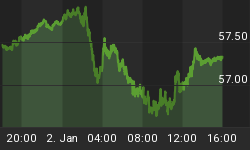In part I, I stated that it was useful to use the monthly charts to gain a broader perspective of the price action. Just get rid of most of the indicators and have a look around. Just remember and it is my firm belief that while the price action in and of itself won't tell you what is driving the market, a lot of times the monthly charts may show you the important bigger picture.
Once again, today's exercise is just that - an exercise. It is my interpretation of the monthly charts in key markets. I am using one indicator and some trend lines. There is nothing systematic or mechanical or computerized back testing about this analysis; it is just me looking at the charts trying to determine where key junctures may occur. By identifying where key junctures may occur on the monthly charts, I can be on the lookout for new trends or new intermarket relationships that may cause continuation of or changes in the trend. This is simple but valuable analysis.
The price graphs are constructed in the following manner: 1) over the price graph is the standard Bollinger Band indicator; 2) the bottom plate is a normalized Bollinger Band. Normalizing the indicator means that the bottom band is set to zero and the top band equals one; the indicator (in red) is the value of the closing price in relationship - percent wise- to the upper and lower bands.
Figure #1 is the NASDAQ. As you can see in the bottom panel, the bear market began with the break of trend line AB in October, 2000 (blue down arrow). The market made a nice double bottom and broke above this pattern (trend line CD) in April, 2003. This move was stopped at the old "internal" trend line AB. Presently, the NASDAQ is in pullback mode, and I expect it should get down to trend line EF, which would be approximately 1800 on the price chart. Several other points are worth making. The 38% retracement of the move from Spring 2003 comes in at 1750; this corresponds to my work on the weekly charts, which suggests that the NASDAQ will get to 1750 before closing above 1950. On the other hand, this just appears to be a normal pullback that may be running its course soon. Why do I say this? First, the range of the price bars is small, and second, a quick perusal of the chart shows very few instances where the market was down greater than 4 months in a row- even during the bear market. Bottom line: I think the NASDAQ will see lower prices before closing above the resistance level of 1950 (sorry about not being more specific).
Figure#1/ NASDAQ (monthly)
Figure #2 is the Dow Jones Industrials. The Dow broke lower from a volatility squeeze in the first quarter of 2001. A triple bottom was put in (3 up arrows), and a break of trend line CD in May, 2003 led to higher prices. Currently, I think the Dow can pullback to trend line AB, which is now acting as "internal" support. I think this would correspond to a zone of support between 9300 (middle Bollinger Band) and 9400 (the 38% retracement of the recent move from the Spring, 2003 lows).
Figure #2/ Dow Industrials (monthly)
Figure #3 is the 30 year Treasury bond. I have highlighted the two volatility squeezes that eventually broke to higher prices in 2000 and 2001. The current situation is interesting. First, the 30 year is entering another low volatility situation (narrowing Bollinger Bands). Second, I have highlighted what appears to be a triple top (the "little caps" over the price chart). Third, if price finishes the month below the middle Bollinger Band, this will be the first time since this uptrend started that bond prices have had 2 consecutive closes below the middle Bollinger Band. The middle panel shows the fan like break of trend lines AB and AC; this pattern usually portends lower prices. I have also highlighted the negative divergence (trend line DE) between price and the indicator. Bottom line: A low volatility set up, a triple top, and a fan like break of trend lines suggests a strong move lower in bond prices.
Figure #3/ 30 Year Treasury (monthly)
Lower bond prices and thus higher rates would be consistent with lower prices in the stock market. The important thing to remember here that this is a long term look and this will take time to play out. The headwinds in this market are still present!
The Technical Take
$ monthly charts of NASDAQ and Dow Industrials suggest that support has not been found and lower prices are ahead
$ the 30 year Treasury Bond is setting up for a significant move lower
Thanks for reading and I hope you have found my analysis informative, insightful and profitable....
If you would like more information regarding my methodologies, please contact me at blueguyzee@yahoo.com.
















